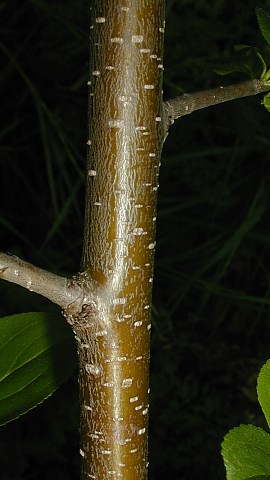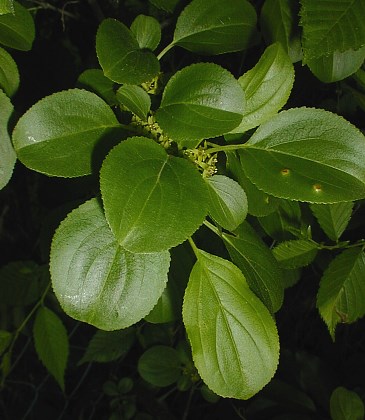Description: This is a small tree or woody shrub up to 25' tall. The bark of the branches is brown and fairly smooth with small white lenticels (air pores); it becomes more rough with age. Some branches have thorn-like tips. The deciduous leaves are mostly opposite, but sometimes alternate; they are up to 2½" long and 1½" across. The leaves are oval, ovate, or obovate, finely crenate along their margins, and hairless (or nearly so); they have rounded bottoms and blunt tips. The upper surface of each leaf is medium to dark green, while the lower surface is light green. The lateral veins of each leaf are strongly curved; there are 2-3 lateral veins on each side of the central vein. Each leaf has a slender petiole up to ½" long.

Small umbels of greenish yellow flowers develop from the axils of the leaves. Usually, the flowers are dioecious with either all male (staminate) or all female (pistillate) flowers on the same plant; less often, the flowers are bisexual (or perfect). Each flower is ¼" across, consisting of a greenish yellow calyx with 4 spreading lobes, 4 insignificant petals, and the reproductive organs. Male flowers have 4 stamens, while female flowers have a pistil. The blooming period occurs from late spring to early summer and lasts about 2 weeks. Fertile female flowers are replaced by small drupes that are nearly black. Each drupe is ¼" across, ovoid in shape, and fleshy, containing 3-4 seeds. The seeds are narrowly grooved. The root system consists of woody taproot. This woody plant spreads by reseeding itself.
Cultivation: The preference is light shade to full sun and moist to slightly dry conditions. This adaptable woody plant tolerates different kinds of soil; it is can reseed itself aggressively and become a pest.
Range & Habitat: Common Buckthorn is occasional to locally common in central and northern Illinois; it is less common or absent in the southern section of the state (see Distribution Map). This species is undoubtedly more widespread than official records indicate – it was introduced into North America from Eurasia as a hedge and landscaping plant. Habitats include floodplain woodlands, disturbed open woodlands, woodland borders, thickets, fence rows, vacant lots, and miscellaneous waste areas. Common Buckthorn has the capacity to displace native plants in their natural habitats.

Faunal Associations: The floral visitors of Common Buckthorn are probably similar to those of the native Lance-leaved Buckthorn (Rhamnus lanceolata), therefore the flowers probably attract Halictid bees (including green metallic bees), Andrenid bees (Andrena spp.), Syrphid flies, and other flies. The bees suck nectar or collect pollen, while the flies suck nectar or feed on the pollen. Common Buckthorn is a winter host of the Soybean Aphid (Aphis glycines). This pest was introduced recently into Illinois and other parts of the Midwest from east Asia. Other insects that feed on this small tree include the Buckthorn Aphid (Aphis nasturtii) and Oystershell Scale (Lepidosaphes ulmi); see Robinson & Bradley (1965), Blackman & Eastop (accessed 2013), and ScaleNet (accessed 2014). Among vertebrate animals, various birds are the primary consumers of the small dark fruits; this includes the American Robin, Gray Catbird, Northern Cardinal, Cedar Waxwing, Swainson's Thrush, Grey-cheeked Thrush, Hermit Thrush, White-breasted Nuthatch, European Starling, Eastern Bluebird, Rose-breasted Grosbeak, House Finch, White-crowned Sparrow, House Sparrow, and Blackpoll Warbler (Craves, 2015). Elk and White-tailed Deer browse on the twigs and foliage of this tree to a limited extent, sometimes also consuming the fruits. Unspecified species of mice reportedly eat the seeds (GISD, accessed 2024; Myers et al., 2004). These animals spread the seeds to new locations. The unpleasant-tasting fruits have a cathartic effect if they are consumed by humans (not recommended).
Photographic Location: Along a fence row at the webmaster's apartment complex in Urbana, Illinois.

Comments: This is probably the most common buckthorn (Rhamnus sp., Frangula sp.) in Illinois. The flowers and foliage are rather ordinary in appearance, although the drupes of female plants are somewhat attractive during the winter. Common Buckthorn differs from another introduced species, Frangula alnus (Glossy Buckthorn), by its 4-lobed flowers, finely crenate leaf margins, and narrowly grooved seeds; Glossy Buckthorn has 5-lobed flowers, smooth leaf margins, and seeds that lack grooves. This latter species prefers damper habitats than Common Buckthorn. Other buckthorns in Illinois (both native and introduced) have more elongated leaves with 4-6 pairs of lateral veins. In contrast, Common Buckthorn has 2-3 pairs of lateral veins per leaf. Occasionally new species of buckthorn escape from cultivation (Rhamnus davurica, Rhamnus japonica, & Rhamnus utilis are examples), although it remains to be seen how invasive these introduced species will become.